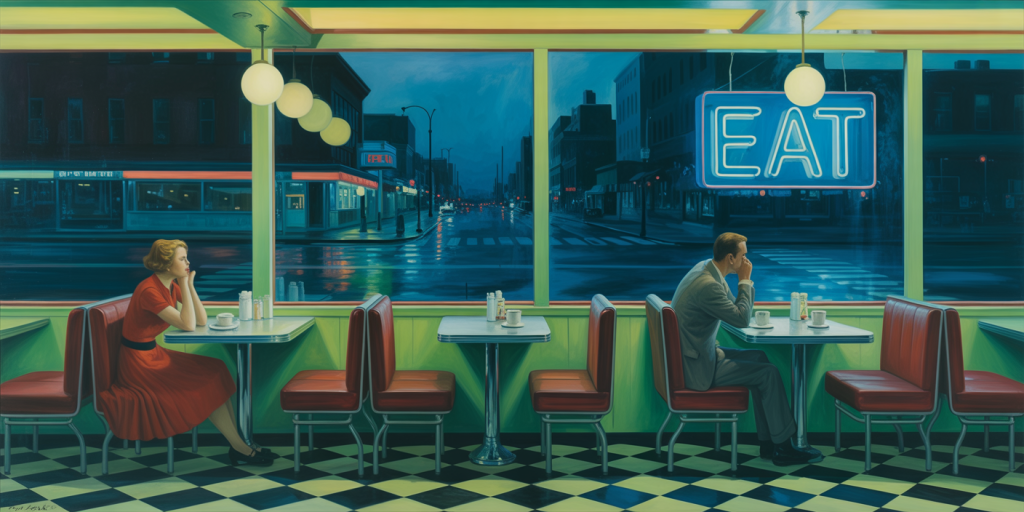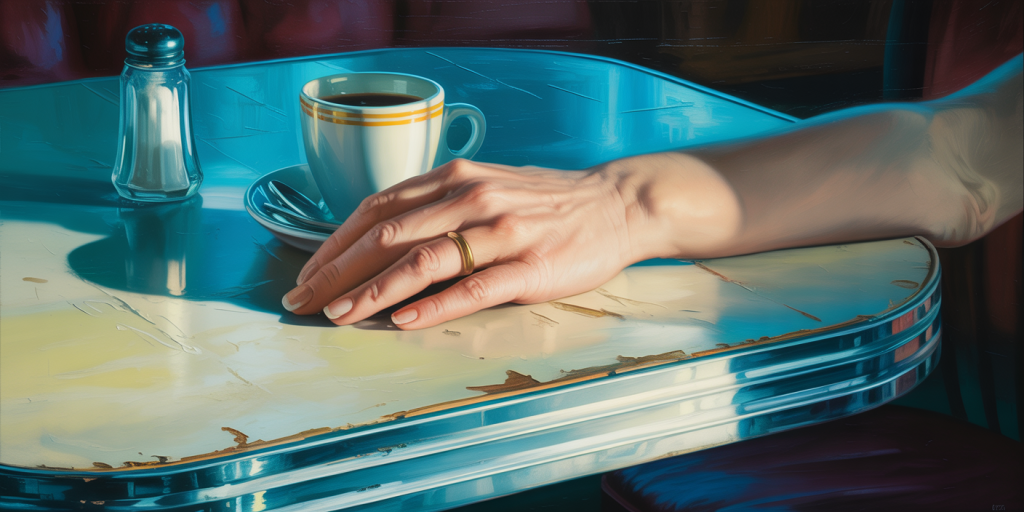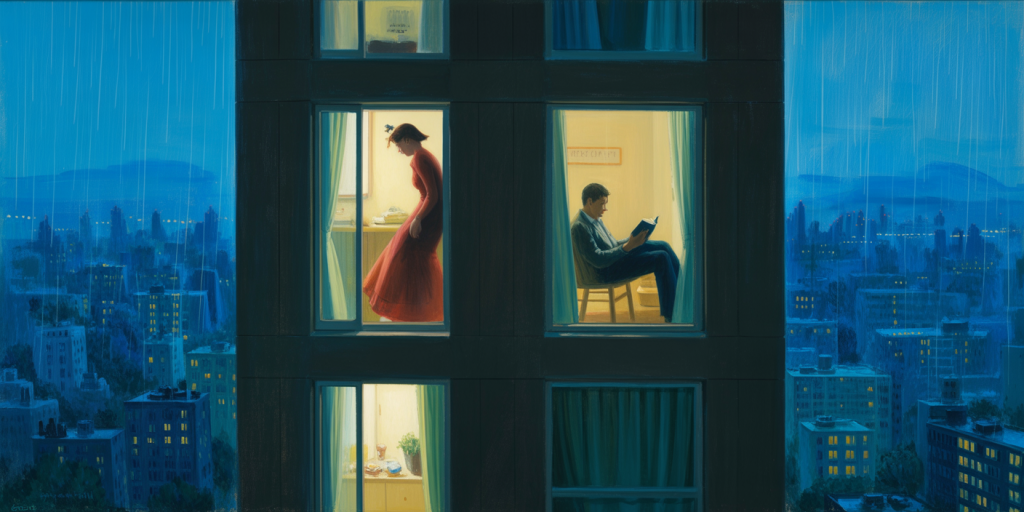The Blue Nights of Hopper and the Loves That Don’t Return
There are nights that never end, not because the clock stops ticking, but because the silence expands, swallowing everything. In Hopper’s world, those nights are painted in shades of blue that do not soothe, but ache. They linger in the windows left glowing, in cafés half-emptied by solitude, in the hush between one goodbye and the certainty that no one will return.
A Hopper night breathes slowly. It smells of warm varnish and cold porcelain, of lamplight diffused by curtains that were never drawn closed. It is in these nocturnal atmospheres, as still as a held breath, that we find stories untold—loves that turned around a corner and never came back, conversations that never rose above a murmur, gazes that crossed paths and forgot each other on purpose.
Summary
- The Hue of Loneliness
- Still Rooms, Breathing Walls
- The Quiet Geometry of Separation
- The Distance Between Faces
- Cafés Like Aquariums of Emotion
- Shadows that Sit in the Chair Beside
- The Architecture of Yearning
- Blue Light, Heavy Air
- The Pause that Outlasts the Sentence
- Doors Slightly Ajar, Hearts Fully Closed
- The Weight of Absence Framed
- Solitude in Cinematic Angles
- Paint that Whispers Forgotten Names
- Reflections in Polished Tables
- When Eyes Look But Don’t See
- A Symphony of Incompletion
- The Echo of a Departing Coat
- Time Measured by Waiting
- The Ghosts that Hopper Invited
- The Lovers in the Far Corner
The Hue of Loneliness
Hopper’s palette is famously restrained, yet it shivers with emotion. In his nocturnes, blue becomes a character—stoic, quiet, wounded. Not the hopeful azure of sky or sea, but a colder, more desaturated shade, like denim soaked in silence. This blue evokes absence more than presence, longing more than love.
His use of color creates not just mood, but memory. We don’t just see the scene—we feel what has already been lost. His blue carries the weight of all the words left unsaid, and all the love that slipped between the fingers like light.

Still Rooms, Breathing Walls
Hopper’s interiors breathe in silence. His rooms are not just settings—they’re emotional ecosystems. A woman sitting by the window is never just waiting; the room waits with her. The chair, the light, the shadow—all conspire to hold her solitude intact.
These spaces are not lonely because they are empty. They are lonely because they contain traces—of voices that once filled them, footsteps that once echoed. His brush freezes the moment just after departure.
The Quiet Geometry of Separation
Compositionally, Hopper is mathematical in how he places his figures. There is no chaos. Every inch is measured, every distance intentional. This precision becomes a metaphor for disconnection.
The angles of tables, the borders of windows, even the direction of a gaze—everything is orchestrated to keep the characters apart. They occupy the same room but live on separate islands.
The Distance Between Faces
Often, the faces in Hopper’s works are turned away from us—or from each other. We see profile, or back of head, or downturned eyes. It is an aesthetic of withdrawal. Expression is reserved, nearly absent, and thus, deeply human.
These are not characters in despair. They are beyond that. They exist in a quiet aftermath. Their sorrow has cooled into stillness.
Cafés Like Aquariums of Emotion
The diners and cafés that populate Hopper’s nocturnal paintings are glass tanks of feeling. Inside, light traps the patrons in clear cubes. Outside, the city yawns open, empty and vast.
In this dynamic, the viewer becomes the outsider—watching through the glass, part voyeur, part ghost. We do not enter the scene; we orbit it, like a memory we can’t reenter.
Shadows that Sit in the Chair Beside
In Hopper’s universe, shadows have weight. They do not simply fall; they occupy. The chair left empty casts its own story across the linoleum floor. Light defines absence as much as form.
Each shadow is a character—echoing the person who once sat there or the one who should have. Their presence lingers, unspoken but undeniable.
The Architecture of Yearning
The buildings in Hopper’s works are not neutral. They tilt slightly toward longing. A wall catches light like a face turning toward warmth. A doorframe suggests a boundary crossed too late.
There is a lyricism to his structures. Even concrete seems to lean in, listening for a sound that never arrives.
Blue Light, Heavy Air
Light in Hopper’s works is less about illumination and more about temperature. A lamp does not brighten—it weighs down. Its blue glow is a velvet cloth laid over the scene, muffling sound, softening hope.
The air is heavy with what is unspoken. You can almost hear it—like a hum that vibrates below hearing.

The Pause that Outlasts the Sentence
There is always a pause in Hopper—a held breath, a hesitation. It’s in the stillness of figures who should be speaking. It’s in the light that touches one person but not the other.
These pauses are not empty. They are full of what might have been said. Hopper paints the silence after the argument, the moment just before the door closes.
Doors Slightly Ajar, Hearts Fully Closed
Doors appear often in Hopper’s scenes—not always open, not quite closed. They mirror the emotional states of the characters, who sit guarded, half-in and half-out of their lives.
These doors suggest possibility, but also finality. The threshold is symbolic. Crossing it would require vulnerability—a step no one takes.
The Weight of Absence Framed
Framing is crucial in Hopper’s compositions. Windows, doorways, mirrors—they all box the characters in, like paintings within the painting.
This framing is not decorative. It is expressive. It contains absence. We feel what’s missing not because it is gone, but because it is framed, displayed, almost worshipped.
Solitude in Cinematic Angles
There is a filmic quality to Hopper’s work—angles that suggest camera stills, compositions that feel paused rather than painted. This adds narrative tension. We expect the next frame, but it never comes.
Hopper freezes the moment before resolution. He gives us the scene, but not the story’s end.
Paint that Whispers Forgotten Names
Hopper’s brushwork is clean, controlled, unfussy. But in that restraint lies his emotional power. He doesn’t shout. He whispers.
His paint is quiet, but it carries names—names of those who left, of lovers who slipped away in the night, of strangers who never returned a glance.
Reflections in Polished Tables
Sometimes, Hopper includes surfaces that reflect—glossy tables, windows at night. These reflections blur, elongate, distort.
They do not offer clarity. Instead, they deepen the mystery. The world is doubled, but not explained. What we see is not what is. Hopper invites us to gaze, not to grasp.
When Eyes Look But Don’t See
Eye contact is rare in Hopper’s work. More often, characters look away—from us, from each other, from themselves.
This averting of gaze creates emotional tension. It suggests things too painful to see. It also implicates the viewer—we too become part of the silence.
A Symphony of Incompletion
Hopper’s scenes feel unfinished—but purposefully so. The glass is not empty or full—it’s mid-sip. The train has not arrived or departed—it’s paused.
This incompletion echoes life’s emotional states. Rarely do we feel resolution. Hopper honors that suspended ache.

The Echo of a Departing Coat
Even movement in Hopper is quiet. A figure leaving the frame does not rush—they glide. A coat lifted from a chair carries more emotion than a kiss.
These gestures are simple, but laden. A departing coat can echo louder than a slammed door.
Time Measured by Waiting
Time does not tick in Hopper. It hovers. A clock might be present, but it’s irrelevant. The real time is measured in waiting—the woman in the dress who doesn’t check her watch, the man who still sits at the table.
These are not moments. They are durations.
The Ghosts that Hopper Invited
Hopper’s worlds are not haunted, but they are never empty. Memory seeps into the walls. Every room holds the echo of those who once sat there. Every chair is half-occupied by ghosts.
These ghosts are not scary. They are tender, melancholic, eternal.
The Lovers in the Far Corner
And finally, there are the lovers—if they can still be called that. They sit at the far corner of the room, apart, silent. Their love is not dead, but transformed—into distance, into ritual, into memory.
They do not reach for each other. They are each other’s mirror, each other’s absence. They are the heart of Hopper.
FAQ
Who was Edward Hopper?
Edward Hopper was an American realist painter known for capturing solitude, isolation, and emotional stillness, especially in urban settings. He worked primarily in the mid-20th century.
What characterizes Hopper’s use of color?
His palette is muted and intentional, with cool tones—especially blues—used to convey emotional restraint and loneliness.
Why are Hopper’s scenes often so still?
His compositions freeze time in transitional moments. Stillness amplifies emotional tension, turning every glance and shadow into narrative.
Did Hopper intend for his work to be sad?
Not necessarily sad—but reflective. His paintings evoke longing, introspection, and the quiet poetry of everyday life.
What is Hopper’s artistic legacy?
Hopper deeply influenced cinematic storytelling, visual narrative, and the portrayal of emotional architecture in both painting and film.
Final Reflections – Notes in the Key of Blue
In the universe of Edward Hopper, night does not end with dawn. It lingers in the rooms we remember, in the silences we keep, in the love that never quite left but never fully stayed.
To look at his work is to listen—to the hush of lamps humming, to the breath before a word, to the ache that settles in the heart when nothing else will.
And in those blue nights, as lovers drift apart across rooms and across time, we are reminded that sometimes, the deepest stories are told not in the embrace—but in the absence of one.
